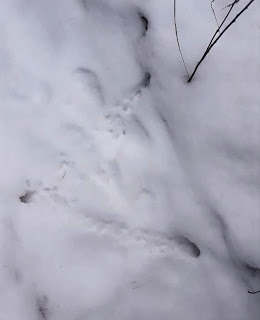Social Distancing Ambassador: Great Gray Owl
Not everyone is eager to mingle. As we revisit one of our past Specimens of the Month, we learn a bit about an owl who has mastered the art of social distancing:
Great gray owls (Strix nebulosa) have a certain mystique about them--as even their species name would indicate. In the Greek origin myth, Strix referred to a bird akin to an owl, with piercing eyes and a nocturnal cry. Nebulosa has Latin origin, meaning mist or cloud. Picture this dark giant watching over a frosty bog below as it silently occupies an evergreen high above. Despite its large appearance, I could still imagine its gray plumage camouflaging into the bark background. Great gray owls are tall, have a long wingspan, and generally appear large--larger than a great-horned owl even. Interestingly, this species has a relatively small body.
I admittedly knew little about the great gray owl before a visitor questioned me about the species one bustling day in autumn. He and his family had been mesmerized by our raptor display as I approached them along the hallway. They had viewed falcons, eagles, and various owls, but all had wanted to see a great gray. I quietly assumed that they wanted to view its relatively large size, something I had been aware of, and motioned over to the collection storage room where a taxidermy mount sat high on the shelves.
The reason this bird looks so large is because they require densely packed feathers for insulation against the cold of its northern habitat. Their need for nutrition thus is satisfied not by rabbits or squirrels, but largely by small voles such as the meadow and southern red-backed voles that occupy the upper Great Lakes region. An owl's highly developed auditory system allows them to hear rodents as they scurry along subnivean tunnels deep under a blanket of snow far away. Rodents like these account for almost 90% of the owl's diet, and so the owl's life is largely dependent on this small critter's presence throughout the year. When the rodent population crashes, the great gray owls have been observed to move southward for food where they may be spotted, although rarely, by humans.
 |
| Evidence of rodents navigating between the cover of snow and the outside world. Unfortunately for them, owls can locate activity under two feet of snow! |
During colder months we might hope for the unlike opportunity to witness such a magnificent raptor in the wild. I have at least viewed excellent images captured by wildlife photographers north into Minnesota. When this species is desperate for food, they may even approach southern portions of Wisconsin.
If you don't anticipate finding this reclusive owl though, consider familiarizing yourself with one of the Museum's specimens. The taxidermy mounts are located safely behind glass and up on shelves--out of reach and away from harm.
